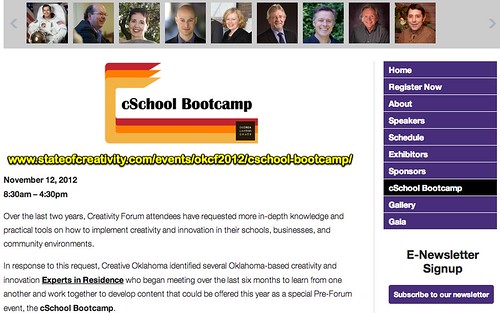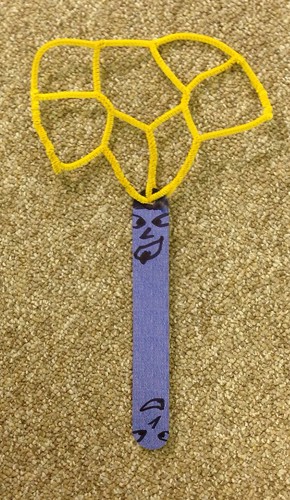These are my notes from a “dry run” / practice of C-School (Creativity School / Creativity Boot Camp) at Creative Oklahoma on October 30, 2012. Please register and join us for C-School in two weeks on Monday, November 12, 2012 in Oklahoma City! This full day workshop precedes the 2012 State of Creativity Forum on November 13th. MY THOUGHTS AND COMMENTS ARE IN ALL CAPS. I’m participating as a volunteer supporting this initiative by Creative Oklahoma Inc.
Opening comments by Kathy Goff, who earned her doctorate studying creativity with Ellis Paul Torrance at the University of Georgia. He developed the Torrance Tests of Creative Thinking.
Creativity is a university ability within all of us, irrespective of our cognitive abilities
– creativity happens every day, it’s a constant in our lives
– we all have it
– question is: have you practiced and developed it?
Many students as well as adults struggle with situations
With creativity you have to be authentic, be yourself
– put yourself out there and let everyone see it
– unfortunately we live in an unkind world, and the world teaches “don’t be creative, you have to do it the right way”
– now we’re discovering kids have been conditioned NOT to think for themselves
– creativity is the answer
– communities need to band together, figure out how to address their challenges with the resources they have together
We are developing an online creativity assessment tool
– people
Torrence identified a slump in creativity about 4th grade
– we tend to stop drawing
– many of us still draw like we did when we were 10, because we stopped practicing
Today we will help you identify different aspects of creativity in your life (some you may not have thought of)
Fluency is one of our first abilities
– coming up with lots of ideas and possibilities
– brainstorming is a tool we use to get at creativity
– collecting ideas, getting more information
Look at the retail arena, the more ideas/possibilities you have, the more likely it is you’ll find something that will work or you can combine to get it to work
2. Flexibility
– being able to look at things from different perspectives
– everyone comes together with different skills and perspectives
– an optical illusion is a simple example of flexibility: you see it one way,then another way
3. Originality
– many people think of patents and trademarks but that’s not all
– every time you do something, it’s original to you
– little “o” is your own originality
4. Elaboration
– the detail person
– sequencing, the elaboration
– a storyteller is a good elaborator
Every time we get into groups we find you need ALL FOUR of these skill sets
This focus is all based on STRENGTHS
– creativity is a natural motivator
Creativity involves being uncomfortable
– you have to be a minority of one
– when you’re not embraced with an idea, especially as a young child, it can be very discouraging
We need to be KINDER, more SUPPORTIVE, and find ways to move ahead with what works
A problem is an opportunity, a challenge to make things BETTER
– this is a proactive perspective
– “this is what we have, so what can we do with this?”
Now hearing from David Burkus:
I’m a big fan of Teresa Amabile‘s work on creativity
– all 3 of her degrees are in Educational Psychology
– she developed “Componential Model” of creativity: where it comes from
– sample article: Creativity and Innovation in Organizations
Dangerous idea about creativity: it’s just limited to a small group
– expertise (domain knowledge)
– creative thinking
– motivation
Whenever 3 elements overlap we can access our creativity
2 general forms of motivation
– intrinsic
– extrinsic
Research shows if you give people the same task, tell 1 there will be a reward at the end and another to do it for fun, you’ll see a MUCH more creative result
MY COMMENT: THIS IS WHY STORYCHASER STUDENT CLUBS NEED TO BE VOLUNTEER, AFTER SCHOOL ACTIVITIES
Don’t underestimate the power of motivation
– when you freedom in structuring your own life, if you find things that are intrinsically motivating you’ll tap far more into your own creativity
Activity: Represent creativity with a tongue depressed and pipe cleaners
My creation:
In all situations, you never know what you’re going to face
Now instead of discussing creativity individually we’ll do this as a group
– make a tableau and photograph a representation of creativity
Now the 2nd block (202) focusing on fluency
– generating a LOT of ideas
A lot of us want to share our ideas with the world
– we want others to embrace and adore our ideas, but instead many people start to attack our ideas
– between 8 and 12 years old we learn inhibition, it’s embarrassing to put ideas out there and have people scorn them
A lot of us are cooks at home, but we keep that a secret at work
– some write music but don’t share it
We need instead to practice divergent thinking
– remove inhibition to sharing ideas
– we want to let our ideas be fruitful and multiply
for many adults, we’ve practiced NOT sharing our ideas for YEARS
– from 10 ideas we can get 100
– defer judgment for now
Rules for Brainstorming:
1- Don’t rain on my parade (every idea is valuable, record them all)
2- Take a walk on the wild side (create breakthrough ideas by stretching crazy/off the wall possibilities)
3- The more the merrier
4- Lean on Me (combine new ideas)
5- Focus x3 (don’t allow discussion/questions during brainstorming – no evaluation at this point, it’s just focused on IDEAS!)
You have to see where people are coming from
– you get a feel for your group
– you’ve been brought together to deal with a challenge
MY THOUGHT: I’D LIKE TO SEE A GROUP OF COMMUNITY MEMBERS IN OUR NEIGHBORHOOD IN OKC TO ADDRESS THE CHALLENGE OF IMPROVING AND HELPING OUR NEIGHBORHOOD SCHOOLS, ESPECIALLY OUR NEIGHBORHOOD HIGH SCHOOL (JOHN MARSHALL HIGH SCHOOL)
Now hearing from economics professor Erik Guzik
it’s not just the production of ideas and the distribution of new ideas
– that is a part, but it’s also about producing something new / different / unique
Flexibility is different than fluency
– fluency is generation of ideas
– flexibility is we can generate different kinds of ides (different types or categories: looking for variation, new perspectives, alternative)
— if we don’t have variation (just production) we don’t have creativity
— this is following Torrence’s ideas on creativity
We are looking for ALTERNATIVES, this is what creativity is
Flexible thinking involves shifting gears, changing paths, wearing another’s shoes, viewing through a new lens, seeing with new eyes, getting at it from new angles
Story: fewer colors are used in very old, historic documents
– black and white
– then yellow and green are introduced
– in written record, blue is the last color to appear (it’s economically a very challenging pigment to produce – Egyptians had it, so they had a word for it)
– once we understand a concept and a category, something happens in our mind so we an use it in a new way
How do you express thanks?
– verbally
– with gifts
– with physical response
THIS REMINDS ME OF THE FIVE LOVE LANGUAGES BOOK WE STUDIED IN “SPIRITUAL PARENTING” LAST SPRING
Show “Storage Wars” is introducing new terms / vocabulary into the American vernacular
Story of Coast Soap: created as blue with a vision for an experience
You know you are achieving flexibility with your creativity when some people react with: “No, that’s not it…”
Looking at images with a new set of ideas, from a different perspective, from a different category
How do we become more flexible thinkers
– it’s hard and we’re often criticized for it
– creativity with flexible thinking requires that we change patterns, forge new connections, see things from new perspectives, and make mental leaps
– we need a nudge, we need tools and methods to help us become more flexible thinkers
Originality
– a descriptor that denotes the novel, unexpected and unique
original thinking entails
– rare connections
– the creative spark
– the eureka moment
– the farthest reaches of divergent thinking
Research on creativity shows: When you respond to a problem or challenge, the initial responses you generate are the expected ones
– very fluent, but very expected (not very original)
– 2nd third of responses moves to new categories of ideas
– 3rd third of the responses begins to reflect original ideas, you run out of expected ideas and are forced to innovate
Question: What are some new and unusual uses for rice
– food, pudding, paper, for construction, a type of cement, absorb water from cellphone dropped in water, use as cell phone bling (spray point then glue on cover), use as basis for biofuel
The natural reaction to some of these original ideas is: “That’s not the way you’re supposed to do that”
Story about CEMEX in Mexico, using cement for low cost housing
– innovating with housing/building projects which are low cost but also increases their product sales
Present people with an incomplete figure
– ask people to complete them, this can force people to think originally / creativity
Improv activity: Zip, Zap, Zing
– one person looks at someone and says zip, that person looks at someone else and says zap, then another zing… repeat.
Activity: Think of a problem in your idea or life you’d like help with
Hits: A quick way to identify the options that stand out. Method: use sticky dots or a pen to mark (“hit”) the most interesting, innovative, intriguing, compelling, etc.
When you see an idea ‘sparkle’ add a dot to it
– in a workgroup this can be good because it’s almost anonymous, people won’t just vote for what their manager thought of
Good to get people up on their feet, active (sitting too long in one place takes the blood out of your head!)
– Zip/Zap/Zing is good strategy that is non-threatening, interactive, and fun
Might get 20-25 ideas initially, usually these are OLD ideas
– then after a diversion activity, something that is totally different, do another brainstorm on the same or similar issues and you’ll get some divergent ideas
– your ideas knows to release those ideas
– our brain knows when we’ve written something down, we can release it and make room for NEW ideas
– out of 120 ideas you can generate in about an hour with a group, you will get 5-8 really original ideas
work through these with clustering strategies
In a ‘normal’ meeting many creative ideas might be suppressed
– good leaders and managers tend to have less inhibition
– problem is often the ‘yes, man’ dynamic
When you ‘incubate’ an idea (take a break) the affective side of your brain kicks in, hunches & gut feelings can lead us
Now hearing from David Burkus
Design thinking involves multiple steps, these five:
1- research
2- define
3- ideate
4- prototype
5- test
We want empathy, have the perspective of someone else
brainstorm the problem and identify the constraints
– some are fixed constraints, others are dynamic
4 categories of constraints which new prototypes typically face in society:
1- organization
2- industry
3- technology
4- society
WE SPEND TIME BRAINSTORMING CONSTRAINTS AS WELL AS A 3 STEP ACTION PLAN. THIS WAS A GREAT EXPERIENCE, AND I HIGHLY COMMEND C-SCHOOL TO YOU! JOIN US IN OKLAHOMA CITY ON NOVEMBER 12TH!


